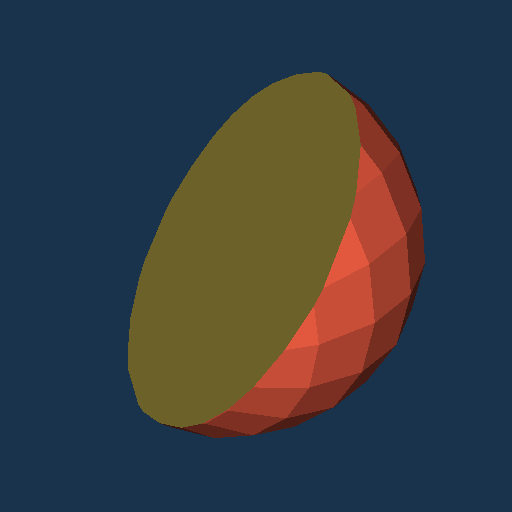CapClip
Repository source: CapClip
Description¶
This example shows how to generate a "cap" on a clipped polydata. It uses a clever trick to convert polylines into polygons. If a polydata file (.vtp) is provided, it will cap it. Otherwise it caps a clipped sphere.
A tutorial on how to setup a Windows Forms Application utilizing ActiViz.NET can be found here: Setup a Windows Forms Application to use ActiViz.NET
Note: As long as ActiViz.NET is not build with VTK version 6.0 or higher you have to define the preprocessor directive VTK_MAJOR_VERSION_5.
Question
If you have a question about this example, please use the VTK Discourse Forum
Code¶
CapClip.cs
using System;
using System.Collections.Generic;
using System.ComponentModel;
using System.Windows.Forms;
using System.Diagnostics;
using Kitware.VTK;
namespace ActiViz.Examples {
public partial class Form1 : Form {
public Form1() {
InitializeComponent();
}
private void renderWindowControl1_Load(object sender, EventArgs e) {
try {
CapClip(null);
}
catch(Exception ex) {
MessageBox.Show(ex.Message, "Exception", MessageBoxButtons.OK);
}
}
private void CapClip(string filePath) {
// PolyData to process
vtkPolyData polyData;
if(filePath != null) {
vtkXMLPolyDataReader reader = vtkXMLPolyDataReader.New();
reader.SetFileName(filePath);
reader.Update();
polyData = reader.GetOutput();
}
else {
// Create a sphere
vtkSphereSource sphereSource = vtkSphereSource.New();
sphereSource.SetThetaResolution(20);
sphereSource.SetPhiResolution(11);
vtkPlane plane = vtkPlane.New();
plane.SetOrigin(0, 0, 0);
plane.SetNormal(1.0, -1.0, -1.0);
vtkClipPolyData clipper = vtkClipPolyData.New();
clipper.SetInputConnection(sphereSource.GetOutputPort());
clipper.SetClipFunction(plane);
clipper.SetValue(0);
clipper.Update();
polyData = clipper.GetOutput();
}
vtkDataSetMapper clipMapper = vtkDataSetMapper.New();
#if VTK_MAJOR_VERSION_5
clipMapper.SetInput(polyData);
#else
clipMapper.SetInputData(polyData);
#endif
vtkActor clipActor = vtkActor.New();
clipActor.SetMapper(clipMapper);
clipActor.GetProperty().SetColor(1.0000, 0.3882, 0.2784);
clipActor.GetProperty().SetInterpolationToFlat();
// Now extract feature edges
vtkFeatureEdges boundaryEdges = vtkFeatureEdges.New();
#if VTK_MAJOR_VERSION_5
boundaryEdges.SetInput(polyData);
#else
boundaryEdges.SetInputData(polyData);
#endif
boundaryEdges.BoundaryEdgesOn();
boundaryEdges.FeatureEdgesOff();
boundaryEdges.NonManifoldEdgesOff();
boundaryEdges.ManifoldEdgesOff();
vtkStripper boundaryStrips = vtkStripper.New();
boundaryStrips.SetInputConnection(boundaryEdges.GetOutputPort());
boundaryStrips.Update();
// Change the polylines into polygons
vtkPolyData boundaryPoly = vtkPolyData.New();
boundaryPoly.SetPoints(boundaryStrips.GetOutput().GetPoints());
boundaryPoly.SetPolys(boundaryStrips.GetOutput().GetLines());
vtkPolyDataMapper boundaryMapper = vtkPolyDataMapper.New();
#if VTK_MAJOR_VERSION_5
boundaryMapper.SetInput(boundaryPoly);
#else
boundaryMapper.SetInputData(boundaryPoly);
#endif
vtkActor boundaryActor = vtkActor.New();
boundaryActor.SetMapper(boundaryMapper);
boundaryActor.GetProperty().SetColor(0.8900, 0.8100, 0.3400);
// get a reference to the renderwindow of our renderWindowControl1
vtkRenderWindow renderWindow = renderWindowControl1.RenderWindow;
// renderer
vtkRenderer renderer = renderWindow.GetRenderers().GetFirstRenderer();
// set background color
renderer.SetBackground(.2, .3, .4);
// add our actor to the renderer
renderer.AddActor(clipActor);
renderer.AddActor(boundaryActor);
// Generate an interesting view
//
renderer.ResetCamera();
renderer.GetActiveCamera().Azimuth(30);
renderer.GetActiveCamera().Elevation(30);
renderer.GetActiveCamera().Dolly(1.2);
renderer.ResetCameraClippingRange();
}
}
}
